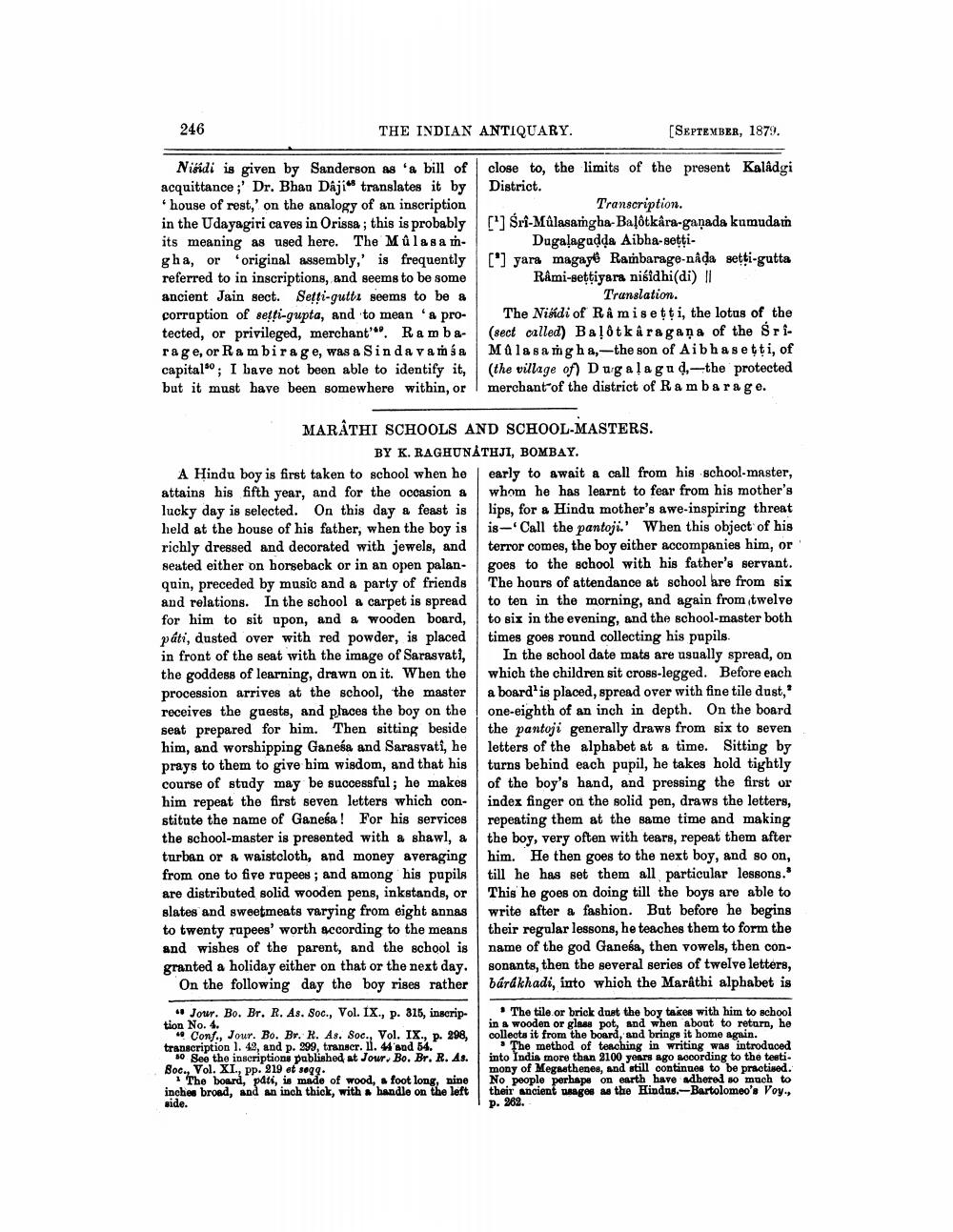________________
246
THE INDIAN ANTIQUARY.
Nisidi is given by Sanderson as 'a bill of acquittance;' Dr. Bhau Dâjis translates it by 'house of rest,' on the analogy of an inscription in the Udayagiri caves in Orissa; this is probably its meaning as used here. The Mûlasa mgha, or original assembly,' is frequently referred to in inscriptions, and seems to be some ancient Jain sect. Seṭṭi-gutti seems to be a corruption of setti-gupta, and to mean 'a protected, or privileged, merchant'. Ramba rage, or Rambirage, was a Sindavamsa capital; I have not been able to identify it, but it must have been somewhere within, or
[SEPTEMBER, 1879.
close to, the limits of the present Kalâdgi District.
A Hindu boy is first taken to school when he attains his fifth year, and for the occasion a lucky day is selected. On this day a feast is held at the house of his father, when the boy is richly dressed and decorated with jewels, and seated either on horseback or in an open palanquin, preceded by music and a party of friends and relations. In the school a carpet is spread for him to sit upon, and a wooden board, páti, dusted over with red powder, is placed in front of the seat with the image of Sarasvati, the goddess of learning, drawn on it. When the procession arrives at the school, the master receives the guests, and places the boy on the seat prepared for him. Then sitting beside him, and worshipping Ganesa and Sarasvati, he prays to them to give him wisdom, and that his course of study may be successful; he makes him repeat the first seven letters which constitute the name of Ganesa! For his services the school-master is presented with a shawl, a turban or a waistcloth, and money averaging from one to five rupees; and among his pupils are distributed solid wooden pens, inkstands, or slates and sweetmeats varying from eight annas to twenty rupees' worth according to the means and wishes of the parent, and the school is granted a holiday either on that or the next day. On the following day the boy rises rather
Jour. Bo. Br. R. As. Soc., Vol. IX., p. 315, inscription No. 4.
Conf., Jour. Bo. Br. R. As. Soc., Vol. IX., p. 298, transcription 1. 42, and p. 299, transcr. 11. 44 and 54.
50 See the inscriptions published at Jour. Bo. Br. R. As. Soc., Vol. XI., pp. 219 et seqq.
The board, pati, is made of wood, a foot long, nine inches broad, and an inch thick, with a handle on the left side.
Transcription. [] Śrî-Mûlasamgha-Balôtkara-ganada kumudaṁ Dugalagadda Aibha-setti
[] yara magaye Rambarage-naḍa seṭṭi-gutta Râmi-seṭṭiyara nisidhi(di) | Translation.
MARATHI SCHOOLS AND SCHOOL-MASTERS. BY K. RAGHUNATHJI, BOMBAY.
The Nisidi of Râ misetti, the lotus of the (sect called) Balôtkâragana of the SriMula sa mgha,-the son of Aib hasetti, of (the village of Duga lagu d, the protected merchant of the district of Ra m barage.
early to await a call from his school-master, whom he has learnt to fear from his mother's lips, for a Hindu mother's awe-inspiring threat is-Call the pantoji.' When this object of his terror comes, the boy either accompanies him, or goes to the school with his father's servant. The hours of attendance at school are from six to ten in the morning, and again from twelve to six in the evening, and the school-master both times goes round collecting his pupils.
In the school date mats are usually spread, on which the children sit cross-legged. Before each a board' is placed, spread over with fine tile dust," one-eighth of an inch in depth. On the board the pantoji generally draws from six to seven letters of the alphabet at a time. Sitting by turns behind each pupil, he takes hold tightly of the boy's hand, and pressing the first or index finger on the solid pen, draws the letters, repeating them at the same time and making the boy, very often with tears, repeat them after him. He then goes to the next boy, and so on, till he has set them all particular lessons." This he goes on doing till the boys are able to write after a fashion. But before he begins their regular lessons, he teaches them to form the name of the god Ganesa, then vowels, then consonants, then the several series of twelve letters, bárákhadi, into which the Marathi alphabet is
The tile or brick dust the boy taxes with him to school in a wooden or glass pot, and when about to return, he collects it from the board, and brings it home again.
The method of teaching in writing was introduced into India more than 2100 years ago according to the testimony of Megasthenes, and still continues to be practised. No people perhaps on earth have adhered so much to their ancient usages as the Hindus.-Bartolomeo's Voy., p. 262.




